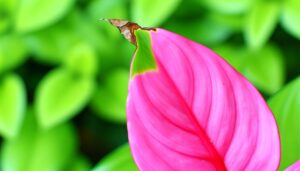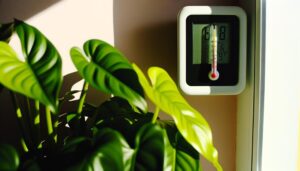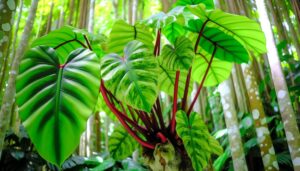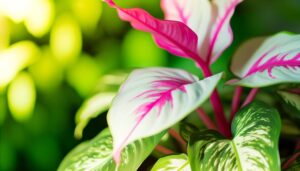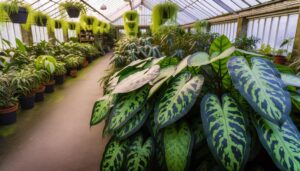What Is a Philodendron Erubescens Hybrid?
Philodendron erubescens hybrids are cultivated variants of a native Colombian rainforest plant, distinguished by robust climbing abilities and vivid foliage. These plants exhibit variegated leaves with hues ranging from pink in the 'Pink Princess' hybrid to deep red stems in the 'Red Emerald' variety.
Thriving in high humidity with filtered light, they are well-adapted to different indoor conditions and are relatively pest-resistant. Ideal growth conditions include well-draining soil, consistent moisture, and temperatures between 65°F and 80°F.
For insights into propagation techniques and specific care instructions, there's more to explore on this fascinating subject.
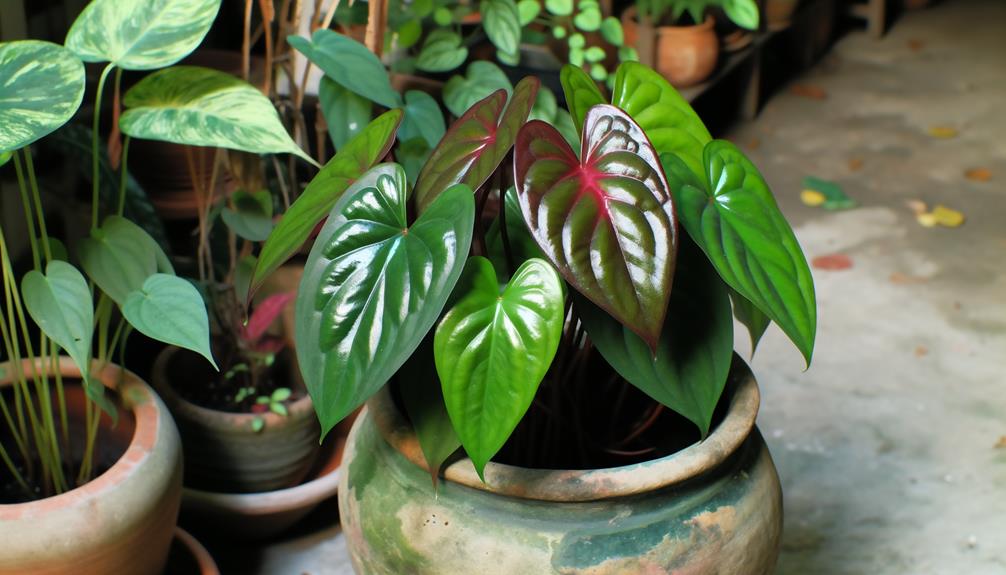
Key Takeaways
- Philodendron Erubescens hybrids are cultivated varieties of the tropical climbing plant native to Colombia.
- They are prized for their vibrant, variegated foliage and robust climbing habit.
- Popular hybrids include 'Pink Princess' and 'Red Emerald,' known for their unique leaf colors and patterns.
- These hybrids adapt well to indoor environments with varying light and humidity levels.
- Propagation of these hybrids can be done through stem cuttings, air layering, or tissue culture for mass production.
Origins of Philodendron Erubescens

The Philodendron erubescens, a species native to the tropical rainforests of Colombia, is renowned for its robust climbing habit and vibrant, reddish foliage. This perennial plant thrives in the understory of dense forests, where it benefits from high humidity and filtered light.
Originating in the rich, biodiverse ecosystems of Colombia, it plays a pivotal role in the intricate web of tropical biodiversity. The species' natural habitat provides a moist and shaded environment, ideal for its growth and development. Over time, Philodendron erubescens has adapted to these specific ecological conditions, which have influenced its morphological and physiological characteristics.
Understanding its origins offers valuable insights into its cultivation requirements and potential applications in horticultural practices.
Key Characteristics
Key characteristics of Philodendron erubescens hybrids include their strikingly variegated leaves, robust climbing ability, and adaptability to a range of indoor environments.
The foliage often exhibits a spectrum of colors, from deep greens to vibrant reds, with some variants showcasing intricate patterns of white or yellow. Their vigorous climbing nature is supported by aerial roots, enabling them to ascend trellises or other supports.
These hybrids are highly adaptable, thriving in various lighting conditions, from low to bright indirect light, and tolerating a range of humidity levels.
Additionally, Philodendron erubescens hybrids generally exhibit a strong resistance to common pests and diseases, making them an ideal choice for indoor horticulture enthusiasts seeking both aesthetic appeal and ease of maintenance.
Popular Hybrid Varieties
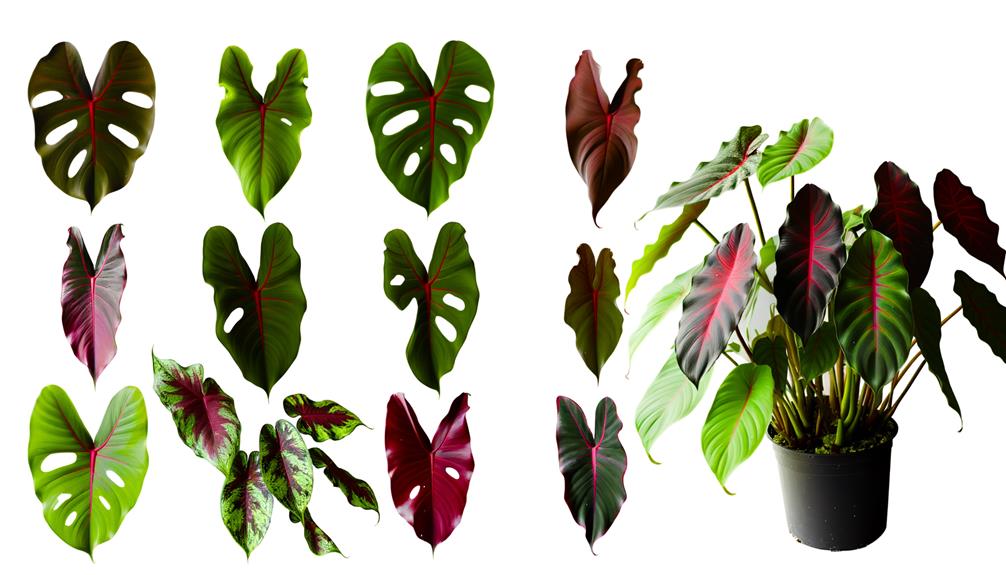
Among the notable hybrid varieties of Philodendron Erubescens, the 'Pink Princess' is distinguished by its striking variegated leaves featuring vibrant pink and dark green hues.
Another prominent variety, the 'Red Emerald,' is characterized by its elongated, lanceolate leaves with deep red petioles and a glossy surface.
Both hybrids exemplify the aesthetic and horticultural value that make Philodendron Erubescens a favored choice among plant enthusiasts.
Pink Princess Appeal
Renowned for its striking variegation and vibrant pink-tinted leaves, the Philodendron Erubescens 'Pink Princess' stands out as a highly sought-after hybrid in the horticultural community. This cultivar exhibits a unique pigment distribution, with chlorophyll-deficient sectors manifesting as vivid pink patches on its foliage. The juxtaposition of dark green, almost black, leaves with these pink sections creates a visually appealing contrast.
Known scientifically for its stable variegation pattern, the 'Pink Princess' often requires specific light conditions to maintain its distinctive coloration. This hybrid's aesthetic appeal is further enhanced by its moderate growth rate and ease of care, making it accessible to both novice and experienced plant enthusiasts. Its rarity and visually striking appearance contribute significantly to its desirability.
Red Emerald Features
Characterized by its deep red stems and glossy green leaves, the Philodendron Erubescens 'Red Emerald' stands as a prominent hybrid variety within the species. This cultivar exhibits striking visual contrasts, with vibrant, lanceolate leaves that can extend up to 30 centimeters in length.
The petioles and stems, suffused with a rich burgundy hue, provide a dramatic backdrop to the lustrous foliage. 'Red Emerald' thrives in well-draining, organic-rich substrates, favoring indirect, bright light conditions which enhance its coloration.
Additionally, its vigorous climbing habit necessitates structural support, often achieved through the use of moss poles or trellises. This hybrid's resilience and ornamental appeal make it a favored choice among philodendron enthusiasts and horticulturists alike.
Ideal Growing Conditions
To cultivate Philodendron Erubescens hybrids successfully, ideal growing conditions must include a well-draining soil mix, consistent moisture levels, and indirect, bright light.
The best soil composition should integrate organic matter, such as peat or compost, combined with perlite or orchid bark to enhance aeration and drainage.
Maintaining ambient temperatures between 65°F to 80°F (18°C to 27°C) fosters robust growth while avoiding exposure to cold drafts.
Humidity levels should ideally remain above 60%, replicating the plant's native tropical environment.
Additionally, situating the plant in a location that receives filtered light prevents leaf scorch while promoting vigorous foliage development.
Ensuring these conditions will facilitate the thriving of Philodendron Erubescens hybrids, promoting both aesthetic appeal and physiological health.
Watering Requirements
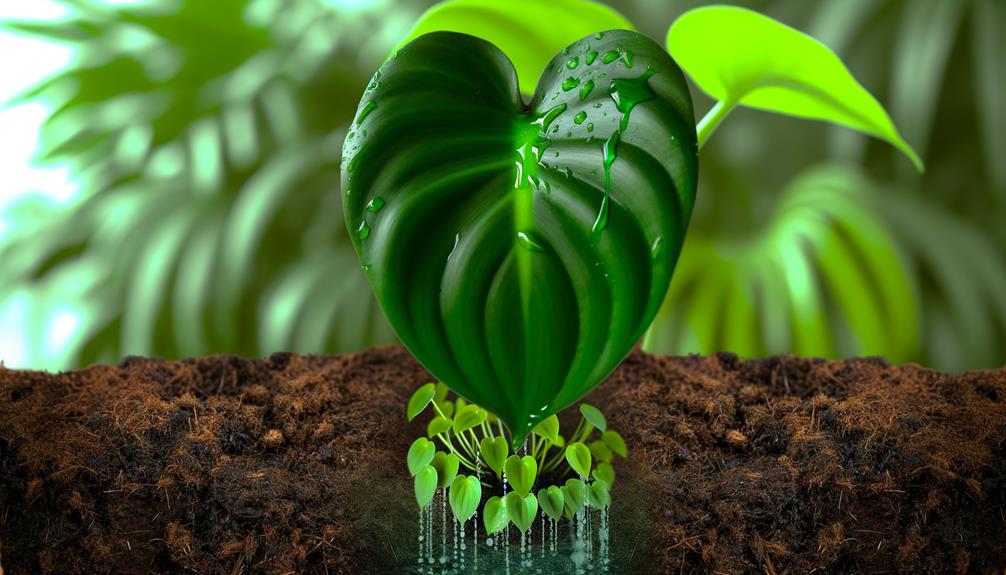
Maintaining appropriate watering practices is essential for the health of Philodendron Erubescens hybrids, necessitating a balance between consistent moisture and preventing waterlogged conditions.
These plants thrive in well-draining soil substrates, which facilitate optimal aeration and mitigate root rot risks.
Watering should be performed when the top 1-2 inches of the soil surface are dry to the touch. Overwatering can lead to detrimental effects such as yellowing leaves and root decay, while underwatering manifests as wilting and stunted growth.
Utilizing lukewarm, dechlorinated water promotes root health. Employing a saucer beneath the pot can prevent excess water accumulation, ensuring proper drainage.
Monitoring environmental humidity levels helps maintain an ideal moisture balance, essential for the plant's physiological processes.
Fertilization Tips
Proper fertilization is crucial for the robust growth and vibrant foliage of Philodendron Erubescens hybrids. Utilize a balanced, water-soluble fertilizer with an N-P-K ratio of 20-20-20, applied bi-weekly during the active growing season (spring and summer). This guarantees an ideal supply of essential macronutrients—nitrogen, phosphorus, and potassium—facilitating photosynthesis, root development, and overall plant vigor.
During the dormant period (fall and winter), reduce fertilization to a monthly regimen to prevent nutrient overload and root burn. Always dilute the fertilizer to half the recommended strength to avoid salinity stress.
Monitor the plant for any signs of nutrient deficiencies, such as chlorosis or stunted growth, adjusting the fertilization schedule accordingly. This precision aids in maintaining the plant's health and aesthetic appeal.
Common Pests and Diseases
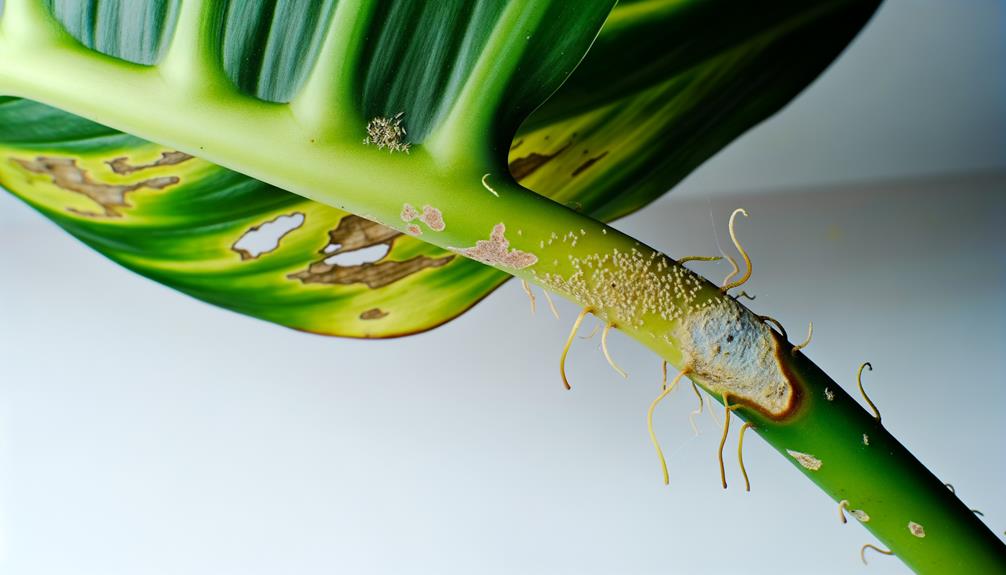
Philodendron Erubescens hybrids are susceptible to a variety of pests and diseases, including spider mites, aphids, mealybugs, and fungal infections, which can greatly impact their health and aesthetic quality. Spider mites cause stippling and webbing on leaves, while aphids secrete honeydew, leading to sooty mold. Mealybugs appear as white cottony masses, and fungal infections manifest as leaf spots or root rot. Early detection and appropriate treatment are essential for maintaining plant well-being. Below is a table summarizing common pests and diseases:
| Pest/Disease | Symptoms | Treatment |
|---|---|---|
| Spider Mites | Stippling, webbing | Insecticidal soap, miticides |
| Aphids | Honeydew, sooty mold | Neem oil, insecticidal soap |
| Mealybugs | Cottony masses | Alcohol swabs, systemic insecticides |
| Fungal Infections | Leaf spots, root rot | Fungicides, improved drainage |
Understanding these issues facilitates effective management and promotes healthier plants.
Propagation Methods
Propagation of Philodendron Erubescens hybrids can be efficiently achieved through stem cuttings, air layering, or tissue culture techniques.
Stem cuttings involve excising a healthy segment of the plant, ensuring it has at least one node and aerial root, then placing it in a sterile rooting medium.
Air layering requires wounding a section of the stem, applying a rooting hormone, and wrapping with moist sphagnum moss, secured with plastic wrap until roots develop.
Tissue culture, a more advanced method, involves sterilizing plant tissue and cultivating it in a controlled, nutrient-rich environment to produce new plants.
Each method offers distinct advantages, with stem cuttings being the simplest, air layering providing higher success rates, and tissue culture enabling mass propagation.
Conclusion
To sum up, Philodendron erubescens hybrids, with their remarkable adaptability and aesthetic appeal, are akin to botanical jewels, enhancing both natural and cultivated environments.
These hybrids thrive under specific conditions, necessitating precise watering, fertilization, and pest management practices. Understanding their origins, key characteristics, and propagation methods is essential for successful cultivation.
As horticultural specimens, they embody both beauty and resilience, making them invaluable to botanical enthusiasts and researchers alike.

